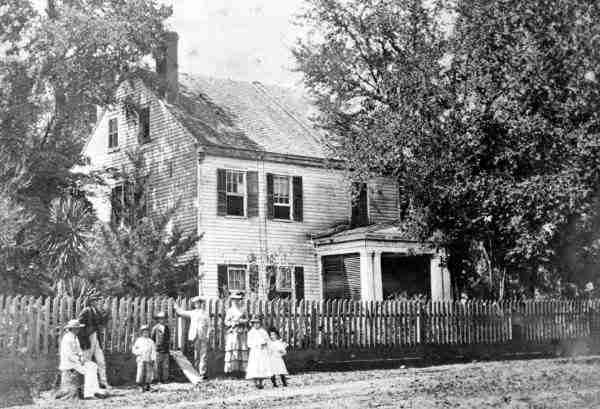Bradfordville Community
Introduction
Text-to-speech Audio
Images
Pine Hill Plantation House ca. 1880

Backstory and Context
Text-to-speech Audio
Dr. Edward Bradford moved to the Tallahassee area from North Carolina in 1832 as did so many of second and third generation planters from the mid-Atlantic states. The fertile soils of the newer territories of the United States offered the prospect of better crops and a fortune to be made. He was followed not long after by his three brothers. All the brothers established plantations in north central Leon County. Dr. Bradford was the most successful of them eventually establishing both Pine Hill Plantation and later Horseshoe Plantation. His brothers established Water Oak Plantation, Walnut Hill Plantation, and Edgewood Plantation.
Dr. Bradford received his medical training from Jefferson Medical College in Philadelphia, PA. His family was allegedly descended from Bradfords that sailed to North America on the Mayflower. His wife, Martha Branch Bradford, was the daughter of Governor John Branch of North Carolina. His background, wealth, and efficiency skills helped him become one of the wealthiest residents in Leon County. He was involved in more than being a physician and a planter.
Bradford owned over one hundred slaves on his plantations. He operated a brickyard, grist mill, sawmill, and kept a staff of professionals to run his businesses. The staff included an engineer, middle managers to operate the production, and an accountant to keep track of everything. His plantations were run by many skilled slaves including a Blacksmith, coopers, craftsmen, and foremen to oversee the field work and housework. Many of the bookkeeping records and receipts of Dr. Bradford’s plantations survived and are housed in a collection at Florida State University. These records show his many dealings with New York mercantile traders selling cotton in the market to be transported via rail to the north or via ship out of Saint Marks, FL.
Bradford was a well-connected and prominent member of Tallahassee society. He conducted business with all the known names of the time. His daughter, Susan, went on to marry into another major Tallahassee family when she married Nicholas Ware Eppes, son of Francis W. Eppes and great-grandson of former President of the United States Thomas Jefferson. He was also a signatory to the Southern Rights Association on secession from the Union for the protection of Southern interests and the vindication of Southern rights. Bradford passed away in 1871 was buried in the family cemetery on the land that was Pine Hill Plantation.
Sources
1.Dr. Edward Bradford Papers, Special Collections & Archives, Florida State University Libraries, Tallahassee, Florida. https://archives-lib-fsu-edu.proxy.lib.fsu.edu/repositories/10/resources/1366 Accessed April 12, 2020.
2.Groene Bertram, Ante-Bellum Tallahassee Tallahassee, FL: Florida Heritage Foundation, 1971, p.31 http://ufdc.ufl.edu/FS00000017/00001/39j.
3.Knott House Museum. Know Your Neighborhood: Tallahassee Street Name Origins. Tallahassee, FL: Knott House Museum, 1997
4.Paisley, Clifton. The Red Hills of Florida: 1528-1865. Tuscaloosa, AL: The University of Alabama Press, 1989.
5.Smith, Julia Floyd. Slavery and Plantation Growth in Antebellum Florida: 1821-1860. Gainesville, FL: Library Press@UF, 2007.
6.Wills, Paul and Martee. “Tallahassee Through the Eyes of Yesterday”, Tallahassee Magazine. November 3, 2015.
Public Domain, https://commons.wikimedia.org/w/index.php?curid=58270070
